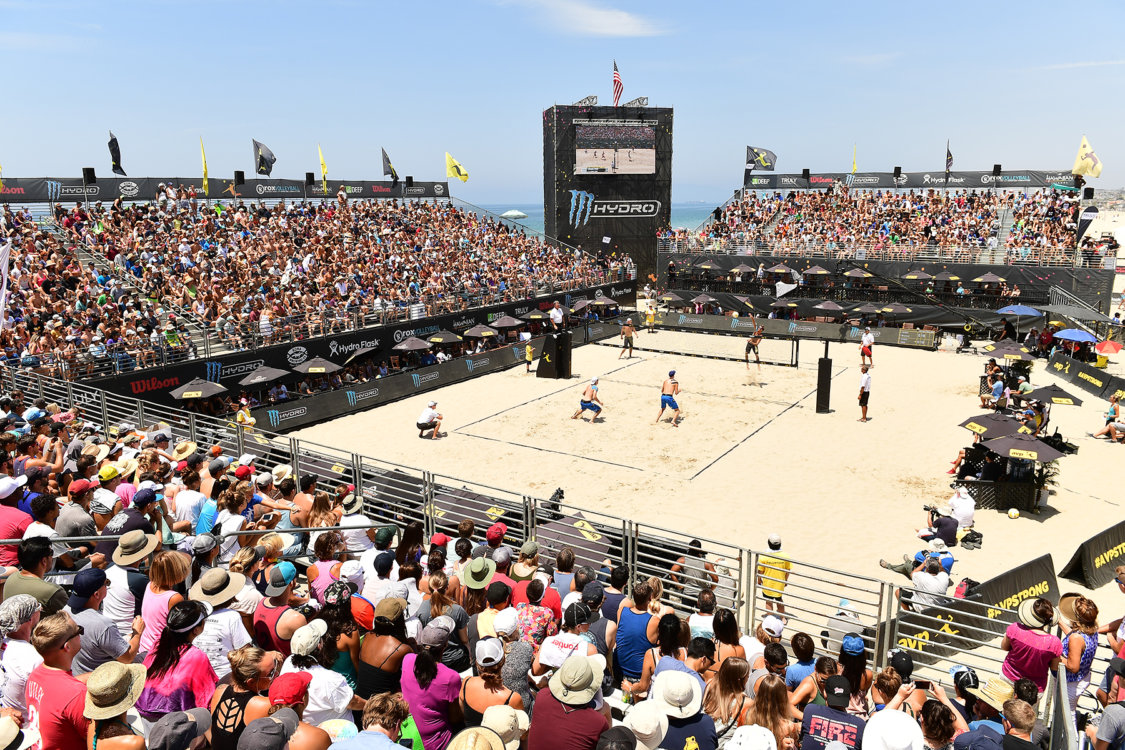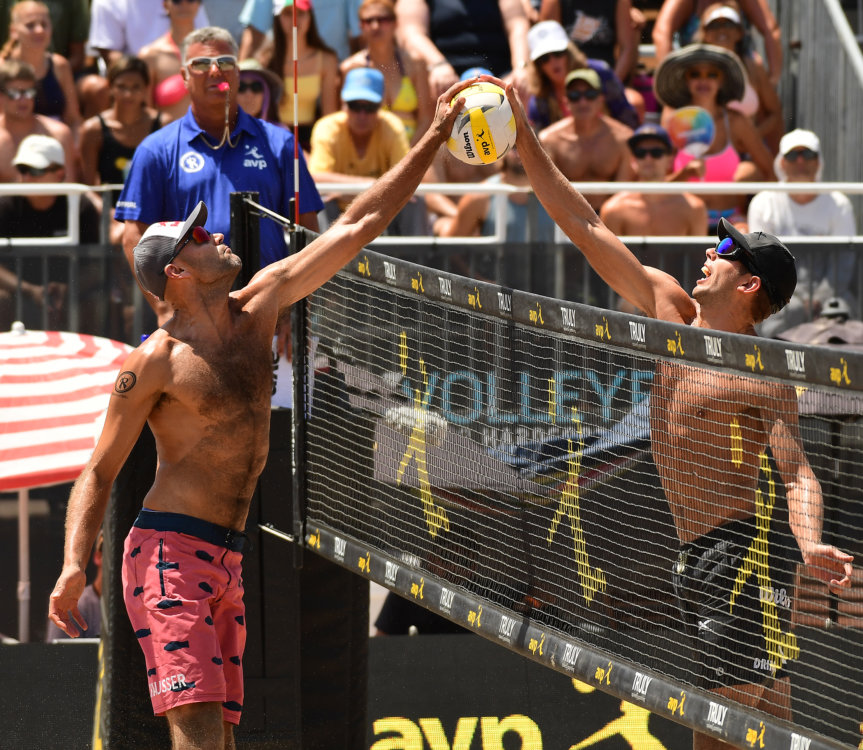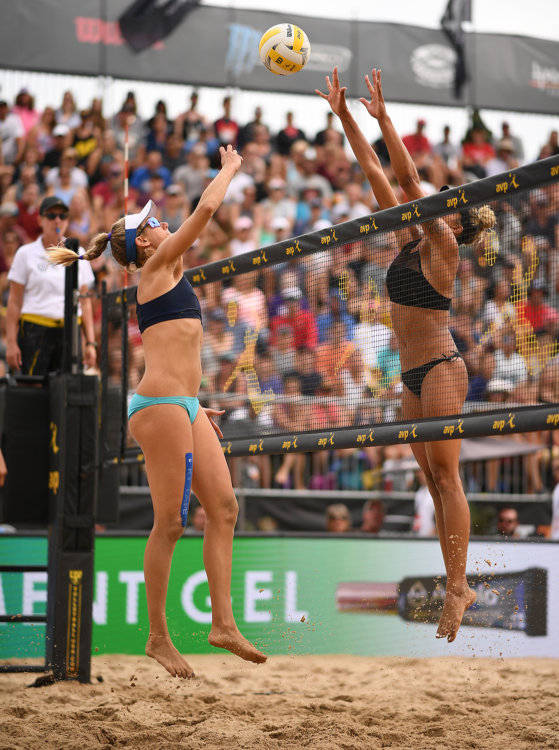Updated by Kim Smith on July 12, 2021.
You walk into an AVP event… you turn on AVP’s feed on Prime Video… you have a date with a volleyball player. What do these three things have in common? You need to know the volleyball lingo to fully enjoy yourself. Sure, you know the sport involves a volleyball net and that volleyball shoes are only needed for the indoor game. But, what are the exact rules of beach volleyball? What is all this terminology Mark Schuermann and our Prime Video announcers are using? We’re here to help you out so you can be that knowledgeable fan in the stands, impress the people around you, or convince your Tinder date you are a volleyball player like them.
What are the rules of volleyball?
These are the things you need to know. AKA the game won’t make sense if you don’t get these.
Rally Scoring: This is the scoring system used today in the AVP and the FIVB (international tour). Every time the ball touches the ground or a whistle is blown, a point is given to a team.
Sideout Scoring: This is the scoring system that was used in the earlier days of volleyball. The only time a point is given is if the team serving makes a play to earn the point. In simpler terms/lingo, you must be serving to get a point.
Entering The Freeze: This rule was introduced at the end of 2016 and is only used on the AVP tour. When a team gets to match point (more on what this means later), both teams switch from Rally Scoring to Sideout Scoring. This is to make the end of matches more exciting and climactic for the fans. There is nothing exciting about winning a gold medal on a missed serve…

21 vs 15: To win a match, a team must win 2 out of 3 sets. Each set goes to 21 points, but you must win by 2 and there is no cap (we have had matches go 32-30). If each team wins one set, they enter the third set which only goes to 15 points (again, win by 2 with no cap).
Three Touches: In both beach volleyball and indoor volleyball, the team touches the ball up to three times before it must be on the other side of the volleyball net. IMPORTANT: In beach volleyball, if the ball touches the blocker (more to come on who this is later), this counts as one of your three touches. Even if it is the smallest touch that the fans didn’t notice, it still counts.
In Bounds Vs Out Of Bounds: A pro is serving or swinging at the ball… the volleyball lands in bounds, it’s a point for them. If it lands out of bounds, it’s a point for the other team. If it lands on the line on the opponent’s side, it’s in. If it hits the antenna, it’s out.
Now, we are getting a little more advanced.
Team Side Switch: No, the teams aren’t switching sides for the fun of it. Yes, there is order to what seems like random switching. Teams switch sides of the net every 7 cumulative points to ensure one team is not on the ‘good side’ the entire match. This is not tracked anywhere besides the ref’s scorecard and in the athletes’ heads. We know, impressive!
Server 1 vs Server 2: Each team member is given a ‘1’ or a ‘2.’ This simply represents the serving order because teams must rotate servers back and forth every time they sideout (more on what this means later). If you watch closely, you sometimes see athletes looking to the ref holding up 1 or 2 fingers (not to be confused with when they hold it behind their backs as blocking signals). This is them asking who is up to serve.
Let Serve: The rule is similar to professional tennis— the ball cannot hit the net and land in bounds on a serve. If it hits the net, the server has another chance but that is his/her final chance. If the serve hits the net and lands out of bounds at any point, it’s ‘out’ and the ball is given to the other team. However, this rule is only in effect during ‘the freeze’ (which was explained earlier).
Uniform Rules: Let’s get this straight— the female athletes are NOT required to wear small bathing suits. The women (and men) can wear whatever they want as long as they match in color and each player has their name (first, last, or nickname) on their uniform. This means athletes can play in leggings, t-shirts, shorts, dresses, one pieces, etc. They just need to match in color and have their name on it. Now we’re sure this part is pretty clear, but we might as well say it anyway… no volleyball shoes or knee pads for beach volleyball.
Double: This call is very easy to understand but can be very hard to call if you’re a ref, fan, or athlete. When an athlete is hand setting, the ball needs to cleanly leave their hands causing no spin, instead launching a ball that floats through the air. The tricky part is that if you see a slight spin on a set, that doesn’t automatically mean it’s a double. And sometimes, a double will be called by the ref when the average fan can’t see the slight spin. This is a tough one, so stay patient.
Lift: A lift is another illegal call that can be tricky to understand and catch in match play. A lift is called one of two ways: 1) The athlete ‘lifted’ the ball with an open, flat hand, or 2) The athlete held the ball in their hands too long while hand setting. The latter option gets really complicated when you see athletes doing the ‘deep dish’ set.
Foot Fault: The only person who is at fault here is the server because they stepped over the back line and into the court when they were serving. If someone is jump serving, you must take off from behind the service line but can land inside the court. Don’t be that fan yelling, ‘foot fault’ on an instance like this because you will be wrong.
What are the volleyball terms I need to know?
Now that you have the basic rules down, here is some terminology that’s good to have in your back pocket.

Match Point vs Set Point: We mentioned this earlier and said there was more to come. So, here it is. A Set Point is also known as Game Point, meaning one team needs one more point to win that game to 21. The Match Point means a team has already won one set and is one point away from winning the match and ending the competition.
Float Serve: Volleyball starts with a serve. Always. A float serve is one style of serving that ball into play. This serve is the most common type but mastered by few because the serve floats through the air, has no spin, and drops quickly on the opposing team. It’s very hard for a passer to track the ball when done correctly.
Jump/Top-Spin Serve: Unlike the Float Serve, the Jump Serve (aka Top-Spin Serve) has all the spin on it. These serves are high-speed with lots of spinning, and usually involve a grunt at contact from the server. Think April Ross and Jeremy Casebeer.
Trickle Serve: Although we have yet to meet anyone who can control this type of serve 100% of the time, it’s important it’s included because it happens a lot in beach volleyball. This is the serve where the ball hits the volleyball net and trickles on to the opponent’s side, making it an ace (read below). Trickle serves are close to impossible to pass.
Ace: Very simple. Serve the ball and it either touches the ground with no one touching it or someone passes it but it’s shanked (explanation on this below) so their partner cannot get to it. Either option results in a point and is an ace!
Set: Not to be confused with a set to 21 points, this is the term used to explain how a partner gets the ball to their partner before they go for a big swing. Players are able to both bump set with their forearms or hand set with their… you guessed it, hands.

Kill: ‘Kill’ usually has a negative connotation but in beach volleyball we love this word. A kill is when an athlete swings, tips, passes, etc. the ball to the other side of the net directly resulting in a point! Points win matches so these are important.
Block: A block occurs when a player at the net tries to physically block the ball as someone on the other side is swinging for a kill.
Dig: Digs occur when the ball goes past the blocker, and the defender (the teammate not at the net) gets the ball before it touches the ground. When someone digs the ball, they prevented their opponent from getting a kill, which would have given them a point, which is what you need to win 😉
Split blocking: Players switch off blocking and defending responsibilities. During service, the non-server stays at the net and blocks the first ball while the other teammate plays defense. After an attack, whichever player hits the ball becomes the blocker. This means during a rally, both teammates could be the blocker multiple times. Examples on the AVP – Tri/Trevor; Karissa/Jace
Congrats! You conquered the above and we think you can take on more.
Line vs Angle: As a fan you most likely hear teammates yelling geometry at their partner on the sand. Line!! Angle!! The point is that they are trying to tell their teammate where to hit the ball for a kill. Line is the side of the court closest to their line (if you are hitting from the right side of the court then the ‘line’ call is to the right side), and angle is the side of the court that is further/across from them (if you are hitting from the right side of the court then the ‘angle’ call is to the left side). When hitters swing out of the middle of the court, partners usually just say right or left.
Jumbo: This is a type of hit at the net that takes practice. A jumbo is when a player swings at the ball, hitting it softly, but adding arc to its trajectory so it lands perfectly deep in the court (but, of course, in bounds). The trick to this is that it looks like the player will drop the ball short and tricks the defender by placing it long for a point. Betsi Flint does this really well so take some notes if you want to try it out.
Joust: This play involves two players at the net, fighting for a ball that is right on top of the volleyball net. Both players jump, with their arms/hands up, ‘jousting’ for the ball. If the ball falls on your opponent’s side, then you won the joust. The key to winning a joust is to always push second but that’s for another day.

Over: Sometimes, a player gets too aggressive during a joust and the ref calls them on the ‘Over’ call. This is when their arms cross the plain of the net, onto their opponent’s side, and obstruct the natural course of the ball. This is illegal.
Vegas Line: We had to include this because it started as a one-time thing and is now a well-known term that others try to imitate. Sean ‘Rosie’ Rosenthal was playing in an AVP event in Las Vegas and he dug the ball and then CRUSHED it line. Not only did he crush it, it was roughly 8 feet off the net (which is hard to do) and it bounced into the stands (also hard to do on sand). It was so impressive that that one swing became a part of volleyball history. Now, when a pro crushes it line, it’s just an attempt at the ‘Vegas Line.’ Watch it for yourself.
Shot: any attack that isn’t hard-driven. This includes cuts, high-lines, jumbos, pokeys, etc.
Cut: a very sharp shot from a player across or away from their body to the opposite side of the court. Ideally, the ball will land just a few feet off the net on the opposite sideline of the attacker.
Pepper: normally a two-person “pass, set, hit” game back and forth. Peppering is how many teams (not coached by John Mayer, who thinks peppering is pointless) start their warm-up.
Attack: any intentional, strategic offensive move that goes from one side of the net to the other – normally referring to hits and shots.
Platform: the flat surface a player’s forearms make when passing.
Target: the ideal place to put the ball. Used in all forms of moving the ball – serving, passing, setting, attacking. “Getting the ball to target” is a common phrase.
Double Elimination, Classic Format: a tournament format in which you have to lose twice to be eliminated. If you keep winning, you play fewer matches but against harder teams in the Winners Bracket (because you’re playing winners of previous matches). If you lose, you play more matches against fellow losers in the Contenders Bracket (aka Losers’ Bracket). The Final is against the winner of the Winners Bracket and the winner of the Loser’s Bracket. If a team has not been beaten heading into the Finals, they must be beaten by their opponent twice. This format is hardly ever used anymore.
Double Elimination, Modern Crossover: If you hear somebody say “Double Elim,” this is likely the format they are talking about. This is the tournament format that the AVP currently uses. Lose two and you’re eliminated, until the Semis; then it’s win or go home. The final two teams remaining in the Winners Bracket face the two teams left in the Contenders Bracket in the Semis. It’s called a “crossover” because of how a team is placed in the Contenders Bracket after losing in the Winners. Think of it like this: if the 1, 2, 3, and 4 seeds make it to the last round of the Winners Bracket, the matchups would be: 1 v 4 | 2 v 3. If the 1 and 2 seeds win, the 3 and 4 seeds head to the Contenders Bracket, and they also crossover to the other side of the bracket. That way, if they were to win the Contenders Bracket and make it to the Semifinals, the 1 would play the 3 and the 2 would play the 4. The Modern Crossover blends the redemptive qualities of double elimination with the excitement of having true Semifinals, and provides more parody at the end of a tournament.
Modified Pool Play: this is the tournament format that the FIVB currently uses. In a 32-team draw, there are 8 pools of 4 teams each. The top seed plays the lowest seed; the two middle seeds play each other. The winners of the first matches then play each other. The winner of that match gets first in pool and automatically advances to the Round of 16. The loser of that match gets second in pool and advances to the Round of 24. The losers of the first matches play each other. The loser is out of the tournament. The winner advances to the Round of 24 as the third team in pool. In the Round of 24, teams that finish second in pool play teams that finish second in pool. Winners advance to play the first-place pool teams in the Round of 16. The tournament proceeds as single-elimination until the Semifinals. Once teams reach the Semifinals, the winners play in the Gold Medal match (with the loser receiving Silver). The Semifinal losers play in the Bronze Medal match (with the loser receiving 4th).
AVP Points: this is something that most people struggle with understanding. Each place in a tournament awards a certain number of points. In a standard 16-team draw, 1st place earns a team 1,050 points per team while a 13th place awards 240 points per team (points are split evenly between partners). Points are awarded to all teams who play, even those who lose their first match in the qualifier. Your AVP Points total is an aggregate of your best four finishes out of the last five tournaments. A player’s AVP Points decide their ranking. Their points added to their partner’s points decide if they qualify for the Main Draw without having to play in the Qualifier.
Stuff: a straight down block.
Six-Packed: got hit in the face with an opponent’s attack.
Pokey: when a player uses their knuckles, normally two side-by-side creating a mini-platform, to lightly attack the ball over the net. Can also be used as an overhand dig, aka a pokey dig.
Cobra: when a player uses the ends of their fingers to attack a ball.
Antennas: The red and white striped poles on the nets that signify a ball being out of bounds. The caveat is if a ball hits the line, it’s in. But if a ball hits the antenna, it’s considered out and the play stops immediately.
Spatch: when a player tries to hit a ball but sorta misses and ends up hitting it much lighter than planned. It often lands nowhere near where they intended it to land. Also called a paintbrush or whiff, though whiff can also mean missing the ball altogether.
Help! Mark is using some volleyball slang and I don’t know what he is saying.
Some of these are volleyball cheers you can use in the stands and some we encourage to leave to Mark, but at least you will know what he is talking about.

Sideout: Although we no longer use Sideout Scoring, the term/cheer ‘Sideout’ is still frequently used among fans, coaches, and teammates. Sideout means to get the ball/serve back from the other team serving. Used in a sentence: “Here we go, ladies. Sideout right now!”
Seal The Net: This again can be used by coaches as a piece of advice or by fans as a volleyball cheer of encouragement. ‘Seal the net’ references a blocker lining the net with their arms or hands so the ball has nowhere to go besides their side of the net. A reminder to seal the net can help avoid the ball hitting a blocker’s hands and rolling down their body on their side of the net. Used in a sentence: “He had absolutely no options. Jake Gibb sealed the net.”
Sky Ball: This one is all for the fans. A Sky Ball is a type of serve that takes a lot of practice and skill, and looks pretty silly (which is why the fans tend to chant for it). The Sky Ball goes crazy, crazy high and lands on the opponent’s side of the net. It’s tricky for the players because they need to track the ball high in the sky with the sun, the wind, and their diminishing court awareness. Used in a sentence: “Come on, Nick Lucena. Give us the Sky Ball!”
Welcome To The Block Party: Have you met anyone who doesn’t like a good block party? We haven’t either. In volleyball, this is a fun saying for a team getting a lot of blocks (either in a row or in a set). To be used in a sentence, when you want to trash talk— “Welcome to the block party.”

At The Technical: There is a technical timeout during each set that is mandatory to take (although, there is no technical timeout in the third set because it goes to 15). The technical timeout comes when the cumulative score between the two teams is 21. So, when you hear Mark say this in Stadium, he is letting you know it’s a technical timeout. Used in a sentence: “It’s 10-11 at the technical.”
French Fries On The Board: Here’s another Mark saying that you should pick up! This can be used when the set is 11-11. Get it? All the 1’s look like french fries. YUM. Used in a sentence: “Ladies and gentlemen, we have french fries on the board.”
Scoop And Deliver: This isn’t an ice cream delivery service but it’s just as good! You can use this expression when an athlete gets a crazy, good dig (the scoop) and they respond with a great smash for the kill (and deliver).
Wrist-Away: Simple, but confusing. A wrist-away swing or a wrist-away shot refers to when an athlete turns their wrist away from the body, in hopes of tricking the defender. Casey Patterson has made a living off this… body facing and looking one way, wrist and ball going another way. Used in a sentence: “And he goes wrist-away for the kill.”
Butter: We aren’t talking about the ingredient you put on corn. This expression is used to describe a perfect set that is too pretty and impresses the volley fans. Used in a sentence: “Sarah Sponcil was dishing out butter to her partner.”
Dirty/Chowdah: Now, this is the exact opposite of the above. When a set comes out of the hands wrong and has a lot of spin on the ball, you may hear Mark talk about the dirty set and most of the time the ref calls it a double (hey, they’re human so they can’t catch them all). Used in a sentence by an angry fan: “Come on, ref! That set was dirty!”
Facial: A facial in beach volleyball is anything but relaxing. Plain and simple, it’s when someone gets hit in the face. Used in a sentence: “Ouch, Phil Dalhausser just gave Chase Frishman a facial.” Sorry, Chase!
Over On Two: In addition to being an expression, this is actually a planned strategy for teams. Going ‘over on 2’ can be somewhat of a trick play. Meaning, instead of using the three touches a team has, they only take two touches to get it over the net. Used in a sentence: “With her dominant left arm, Sarah Pavan loves to go over on two.”
Shank: Forget ‘Orange Is The New Black’ and think trash talk, ‘Shank you very much.’ A shank is when a ball is coming too fast or too strong and the player cannot handle the ball, sending it into the crowd, or the stands, or the DJ booth, or the ref stand, or into the Hudson River (when we play in NYC). Used in a sentence: “I saw Mark Schuermann playing volleyball on 8th Street and he was shanking it left and right.” Sorry, Mark!

Player Terms via Kim Smith
Okay, now we’re veering from the real terms to the ones coined by AVP players. Most aren’t really volley lingo but more just understood different meanings to common words or phrases. – KS
The Game to Get In: the final match of the Qualifier, called such because you “get in” to the Main Draw.
Tour: abbreviation for the AVP Tour. Also a reference to the AVP community.
Quali: abbreviation for Qualifier.
Auto-Main Draw: when a team has enough cumulative points to allot them a spot in the Main Draw without having to play in the Qualifier.
Make it to Friday: when a team qualifies and makes it to the Main Draw, meaning they get to play on Friday.
Make it to Saturday: an understood next-level accomplishment. It’s one thing to make the Main Draw, but another to win a match or two and get to play a second day.
Make it to Sunday: what every team dreams of, almost as much as getting to the finals.
Rehab: can mean anything from stretching and rolling at home to intense physical therapy with a professional. So not the addiction kind of rehab, but still along the lines of healing us from our volleyball addiction. It’s all meant to loosen and restore muscles and soothe aches and pains.
Film/Video: scouting footage on an opponent. Also refers to watching recordings of your practices or matches.
Played Overseas: almost always means formerly played professional indoor volleyball overseas. Occasionally refers to a player having recently competed as an international beach volleyball player.
The List: the pre-tournament list separating the Main Draw athletes from the Qualifier athletes based on their AVP points. Normally, The List comes out the Saturday before the week of the tournament. The List can be a source of pure elation or frustrated dismay (though most players on the cusp have already done their own math to figure out if they’re in or not).
Athletes’ Tent: the tent on site where all the athletes congregate, rest, and eat between matches.
Breakup: even though there are many romantic relationships on tour, breaking up almost always refers to volleyball partnerships. More romantic relationship phrases that beach volleyball has transformed into platonic references to partnerships are: “getting dumped”, “she left me for someone else,” “we’re trying out a few different people,” “we’re texting/talking/having coffee,” “we have great chemistry.”
Players’ Party: a party thrown on Saturday night of an AVP (normally by the McKibbin brothers) for all the players that didn’t make it to Sunday (plus Taylor Crabb). It’s often open to the public and is an evening to drown your sorrows of not being a Champion.
World Tour: another term for the FIVB (Fédération Internationale de Volleyball) Tour – the international tour that qualifies teams for the Olympics.
Well, AVP Family, that’s a start for ya. If there are any terms we missed or any questions you have, let us know by tweeting us at (@AVPBeach) and we will get you up to speed!